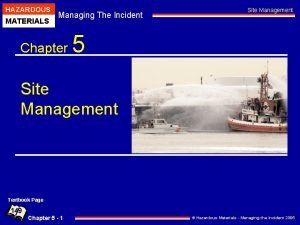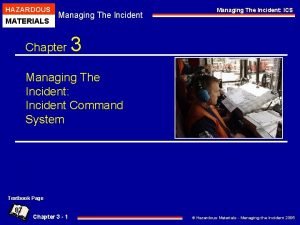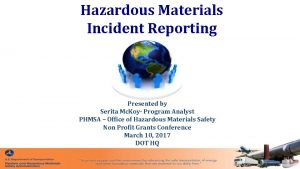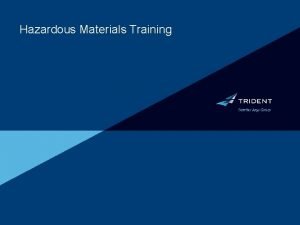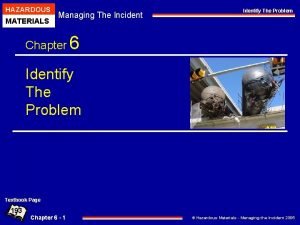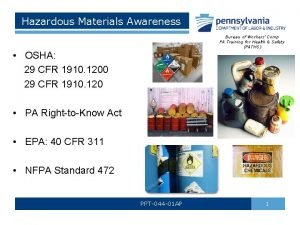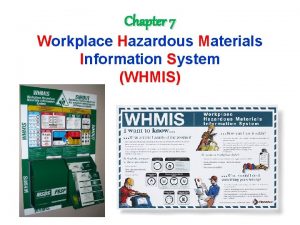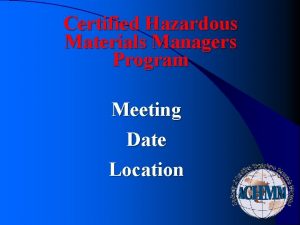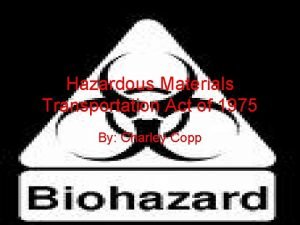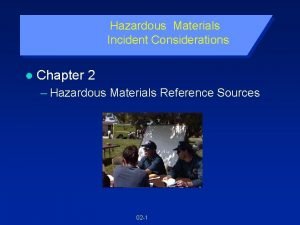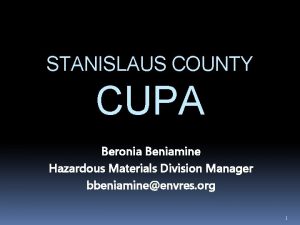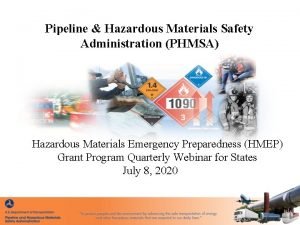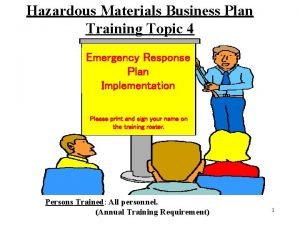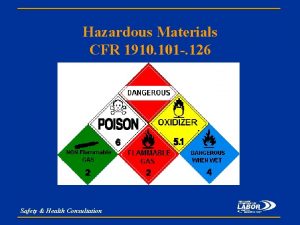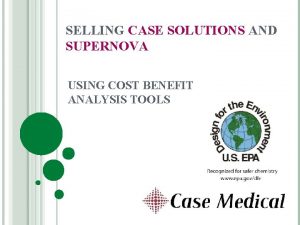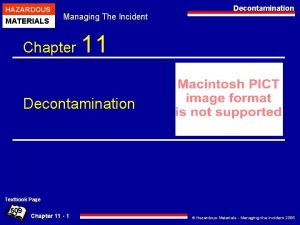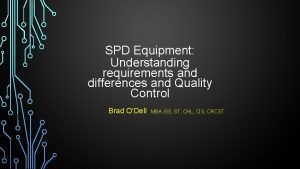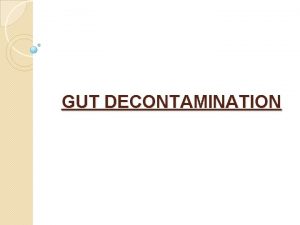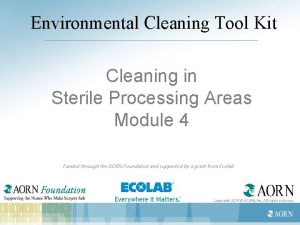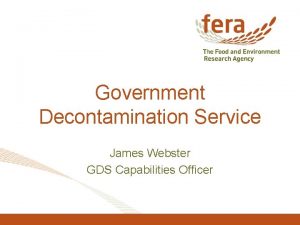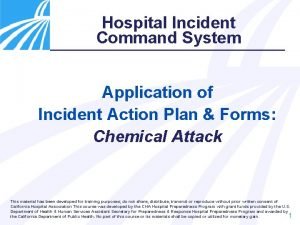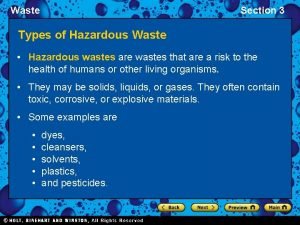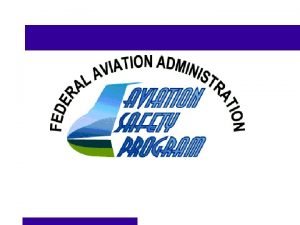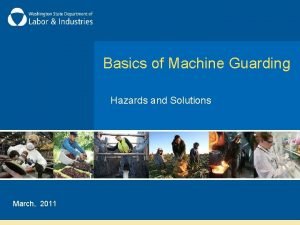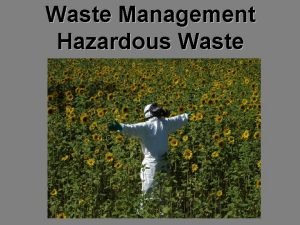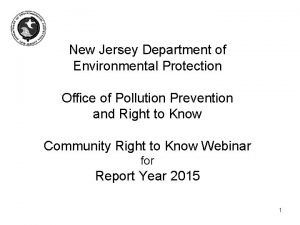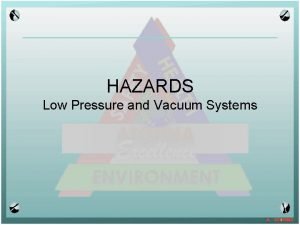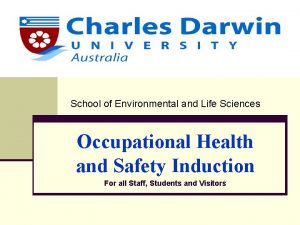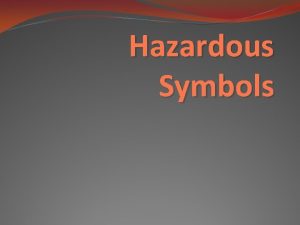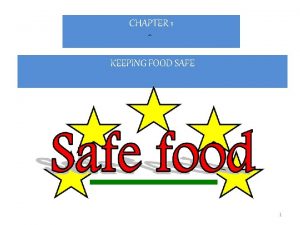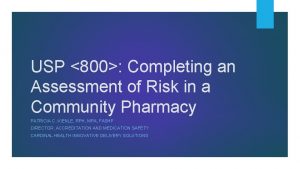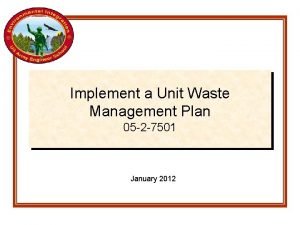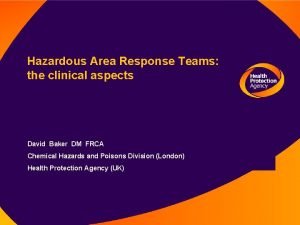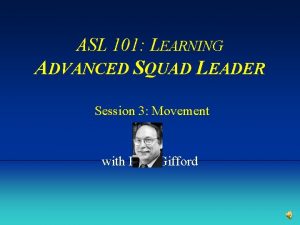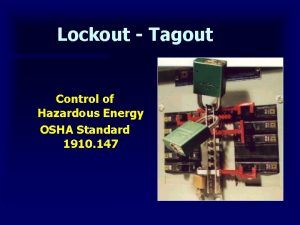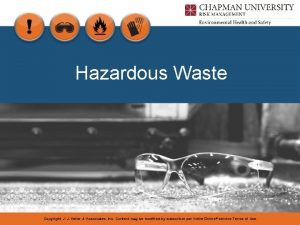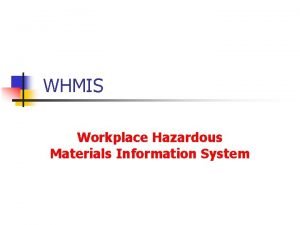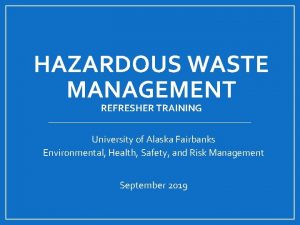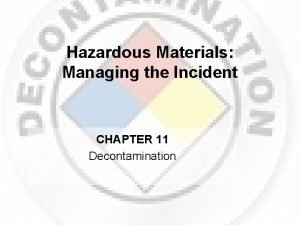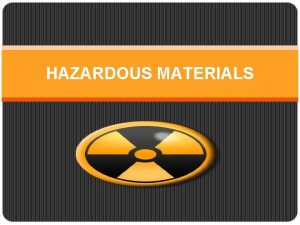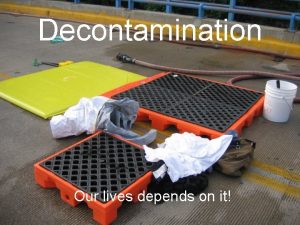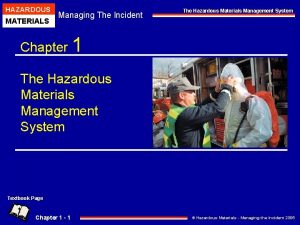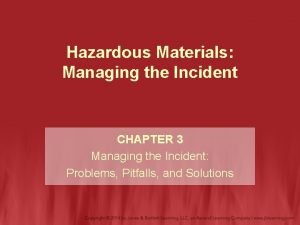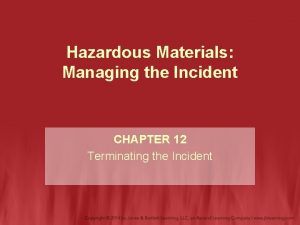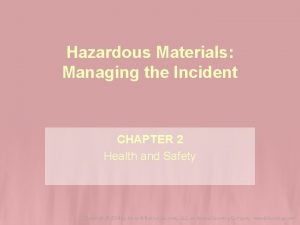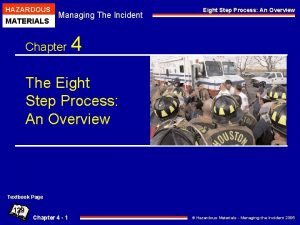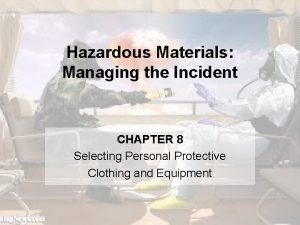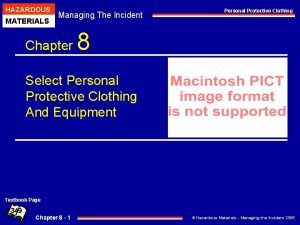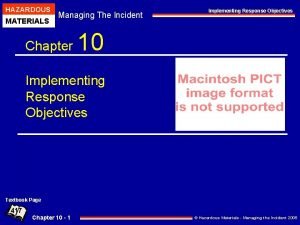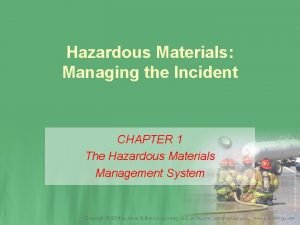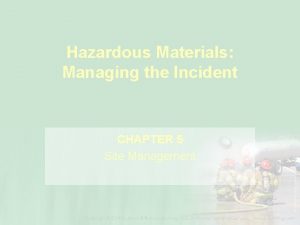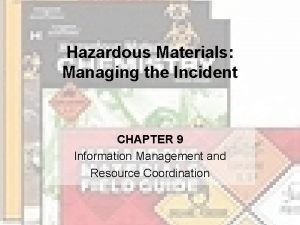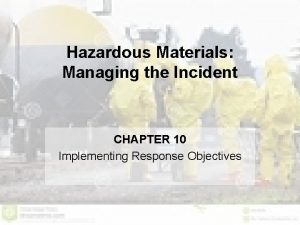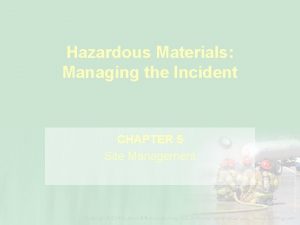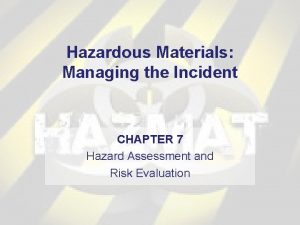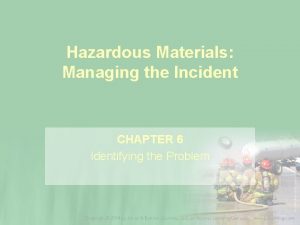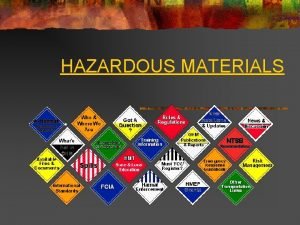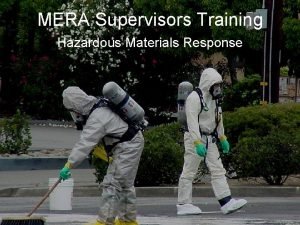HAZARDOUS MATERIALS Managing The Incident Chapter Decontamination 11





































































- Slides: 69

HAZARDOUS MATERIALS Managing The Incident Chapter Decontamination 11 Decontamination Textbook Page 509 Chapter 11 - 1 © Hazardous Materials - Managing the Incident 2005

HAZARDOUS MATERIALS Managing The Incident Decontamination Objectives • Define The Following Terms • • • Area Of safe Refuge Area Contaminant Contamination Decontamination Corridor Decontamination Officer Decontamination Team Degradation Disinfection Emergency Decontamination Chapter 11 - 2 © Hazardous Materials - Managing the Incident 2005

HAZARDOUS MATERIALS Managing The Incident Decontamination Objectives • • Exposure Mass Decontamination Gross Decontamination Technical Decontamination Sterilization Describe The Difference Between Contamination And Exposure, And Their Significance In Decontamination Operations. Describe The Difference Between Surface Contamination And Permeation Contamination, And Their Significance In Decontamination Operations. Chapter 11 - 3 © Hazardous Materials - Managing the Incident 2005

HAZARDOUS MATERIALS Decontamination Managing The Incident Objectives • Describe The Difference Between Direct Contamination And Cross Contamination, And Their Significance In Site Safety Operations. • Define The Following Terms And Describe Their Potential Harmful Effects To The Human Body Relating To Contamination: • • • Highly Acute Toxicity Contaminants Moderate To Highly Chronic Toxicity Contaminants Embryo toxic Contaminants Allergenic Contaminants Flammable Contaminants Chapter 11 - 4 © Hazardous Materials - Managing the Incident 2005

HAZARDOUS MATERIALS Decontamination Managing The Incident Objectives • • • Highly Reactive Or Explosive Contaminants Water Reactive Contaminants Etiologic Contaminants Radioactive Contaminants Describe The Phases Of The Decontamination Process And Their Significance In DECON Operations • • Gross DECON Secondary DECON Chapter 11 - 5 © Hazardous Materials - Managing the Incident 2005

HAZARDOUS MATERIALS Managing The Incident Decontamination Objectives • Describe The Following Types Of Decontamination Operations, And Their Application And Implementation At A Hazardous Materials Incident. • Emergency DECON • Technical DECON • Mass DECON Chapter 11 - 6 © Hazardous Materials - Managing the Incident 2005

HAZARDOUS MATERIALS Managing The Incident Decontamination Objectives • Identify The Advantages And Limitations, And Describe An Example Where Each Of The Following Decontamination Methods Would Be Used: [NFPA 472 6. 3. 4(1)] • • • Absorption Adsorption Brushing And Scraping Chemical Degradation Dilution Disinfection Chapter 11 - 7 © Hazardous Materials - Managing the Incident 2005

HAZARDOUS MATERIALS Decontamination Managing The Incident Objectives • • • Sterilization Evaporation Heating And Freezing Isolation And Disposal (I. E. , “Dry DECON”) Neutralization Pressurized Air Solidification Vacuuming Washing Evaporation Chapter 11 - 8 © Hazardous Materials - Managing the Incident 2005

HAZARDOUS MATERIALS Managing The Incident Decontamination Objectives • • Identify Three Sources Of Technical Information For Selecting Decontamination Procedures And Identify How To Contact Those Sources In An Emergency. [NFPA 472 - 6. 3. 4(2)] Identify Considerations Associated With The Placement, Set-up And Operation Of The Decontamination Area. [NFPA 472 - 6. 3. 4] Chapter 11 - 9 © Hazardous Materials - Managing the Incident 2005

HAZARDOUS MATERIALS Managing The Incident Decontamination Objectives • • • List Three Types Of Fixed Or Engineered Safety Systems Which May Be Used To Assist Emergency Responders In Implementing DECON Operations Within Special Hazmat Facilities. Define The Term "Clean-up" And Its Coordination With Decontamination Operations. Describe Four General Clean-up Concerns When Decontaminating Equipment. Chapter 11 - 10 © Hazardous Materials - Managing the Incident 2005

HAZARDOUS MATERIALS Managing The Incident Decontamination Introduction • Proper DECON Is Essential To Ensure The Safety Of Emergency Responders And The Public. • In This Text, We Have Adopted The Decon Terminology Referenced In NFPA 471, 472 And 473. • The Simplicity Of Decontamination Has Been Compared To Changing An Infant’s Diaper • Remove It From Others • Keep It Off Yourself • Don’t Spread It Around! • DECON Needs To Be An Adaptive And Flexible Procedure Chapter 11 - 11 © Hazardous Materials - Managing the Incident 2005

HAZARDOUS MATERIALS Decontamination Managing The Incident Basic Principles Of Decontamination • The Process Of Decontamination Basically Involves The Physical Removal Or Neutralization Of Contaminants From Personnel And Equipment. • The Entire Process Of Decontamination Should Be Directed Toward Confinement Of The Contaminant Within The Hot Zone And Neutralizing It Within The DECON Corridor To Maintain The Safety And Health Of Response Personnel, And The General Public. • The Best Method Of Decontamination Is To Avoid Contamination. 512 Chapter 11 - 12 © Hazardous Materials - Managing the Incident 2005

HAZARDOUS MATERIALS Managing The Incident Decontamination Terminology And Definitions • • Contaminant Contamination Exposure Decontamination • DECON • Contamination Reduction • Degradation • Disinfection • Sterilization Chapter 11 - 13 © Hazardous Materials - Managing the Incident 2005

HAZARDOUS MATERIALS Managing The Incident Decontamination Terminology And Definitions • • Safe Refuge Area Decontamination Team Decontamination Corridor Phase and Methods of DECON • • • Gross Decontamination Secondary Decontamination Emergency Decontamination Technical Decontamination Mass Decontamination Chapter 11 - 14 © Hazardous Materials - Managing the Incident 2005

HAZARDOUS MATERIALS Managing The Incident Decontamination Understanding The Basics Of Contamination • The Level Of DECON Will Always Be Based Upon The Level Of Contamination. • Four Basic Concepts Of Contamination Are: • How To Prevent Contamination • Surface Vs. Permeation Contamination • Direct Vs. Cross Contamination • Types Of Contaminants Chapter 11 - 15 © Hazardous Materials - Managing the Incident 2005

HAZARDOUS MATERIALS Managing The Incident Decontamination Preventing Contamination • Contamination Is Any Form Of Hazardous Material (Solid, Liquid, Or Gas) That Physically Remains On People, Animals, Or Objects. • Exposure Means That A Person Has Been Subjected To A Toxic Substance Or Harmful Physical Agent Through Any Route Of Entry Into The Body (E. G. , Inhalation, Ingestion, Injection, Or By Direct Contact (Skin Absorption). • A Responder Who Has Been “Contaminated” When Wearing PPE Has Not Necessarily Been “Exposed. ” Chapter 11 - 16 © Hazardous Materials - Managing the Incident 2005

HAZARDOUS MATERIALS Managing The Incident Decontamination Preventing Contamination • Exposures Can Occur Through A Breach Or Failure Of PPE, The Exposure Can Occur If The PPE Is Accidentally Breached During An Operation, But PPE Failures Rarely Happen. • The Most Common Cause Of Contamination Comes From Poor Decontamination And Clean-up Operations. • Consider The Following Basic Principles To Prevent Contamination: • Stress Work Practices That Minimize Contact With Hazardous Substances. Chapter 11 - 17 © Hazardous Materials - Managing the Incident 2005

HAZARDOUS MATERIALS Managing The Incident Decontamination Preventing Contamination • If Contact Is Made With A Contaminant, Move Contaminated ERP Personnel To An Area Of safe Refuge Area Within The Hot Zone Until They Can Be Decontaminated. • Keep Your Respiratory Protection SCBA Or Air Purifying Respirator (Apr) On As Long As Possible During The DECON Process. • Use Of Limited- Use / Disposable Protective Clothing Or Overgarments Can Significantly “Lighten” Your DECON Requirements. • Use A Systematic Approach To DECON. Don’t “Wing It. ” Chapter 11 - 18 © Hazardous Materials - Managing the Incident 2005

HAZARDOUS MATERIALS Managing The Incident Decontamination Surface Vs. Permeation Contamination • Surface Contaminants Are Found On The Outer Surface Of A Material But Have Not Been Absorbed Into The Material. Chapter 11 - 19 © Hazardous Materials - Managing the Incident 2005

HAZARDOUS MATERIALS Managing The Incident Decontamination Surface Vs. Permeation Contamination • Permeation Contaminants Are Absorbed Into A Material At The Molecular Level. Permeated Contaminants Are Often Difficult Or Impossible To Detect And Remove. Chapter 11 - 20 © Hazardous Materials - Managing the Incident 2005

HAZARDOUS MATERIALS Managing The Incident Decontamination Surface Vs. Permeation Contamination • Factors That Influence Permeation Include: • • Contact Time Concentration Temperature Physical State Chapter 11 - 21 © Hazardous Materials - Managing the Incident 2005

HAZARDOUS MATERIALS Decontamination Managing The Incident Direct Vs. Cross Contamination • Direct Contamination Occurs When A Person Comes In Direct Physical Contact With A Contaminant. Direct Contamination Can Also Happen , Or When A Person Comes Into Contact With Any Object That Has The Contaminant On It • Cross Contamination (A. K. A. Secondary Contamination) Occurs When A Person Who Is Already Contaminated Makes Contact With A Person Or Object That Is Not Contaminated. Chapter 11 - 22 © Hazardous Materials - Managing the Incident 2005

HAZARDOUS MATERIALS Decontamination Managing The Incident Direct Vs. Cross Contamination • Once The Contaminated Individual Person Physically Contacts The Uncontaminated Person, The Contaminant Is Transferred And Both Individuals Are Now Contaminated To The Other Person, And They Are Now Also Contaminated. • This Process Of Cross Contamination Can Go On And On, And Spread From One Person To The Next As They Touch More People And Objects. Chapter 11 - 23 © Hazardous Materials - Managing the Incident 2005

HAZARDOUS MATERIALS Decontamination Managing The Incident Types Of Contaminants • The Types Of Contaminants Can Be Divided Into Eight Different Categories Based On Their Primary Hazards. These Include: • • Highly Acute Toxicity Contaminants Moderate To High Chronic Toxicity Contaminants Embryotoxic Contaminants Allergenic Contaminants Flammable Contaminants Highly Reactive Or Explosive Contaminants Water Reactive Contaminants Chapter 11 - 24 © Hazardous Materials - Managing the Incident 2005

HAZARDOUS MATERIALS Managing The Incident Decontamination Types Of Contaminants • Etiologic Contaminants • • Virulence Dose Physical Environment Personal Health Status • Radioactive Contaminants • • Alpha Emmiters Beta Emmiters Gamma Emitters All Three Hazards May Present Chapter 11 - 25 © Hazardous Materials - Managing the Incident 2005

HAZARDOUS MATERIALS Managing The Incident Decontamination Methods • Decontamination Methods Can Be Divided Into Two Basic Categories: Physical And Chemical. • Physical Methods Generally Involve “Physically” Removing The Contaminant From The Contaminated Person Or Object. • Chemical Methods Generally Involve Removing The Contaminant Through Some Type Of Chemical Process. 521 Chapter 11 - 26 © Hazardous Materials - Managing the Incident 2005

HAZARDOUS MATERIALS Decontamination Managing The Incident Examples of Physical Methods • Absorption • Absorbent Works By “Soaking Up” The Contaminant • Adsorption • Adsorbent Adds Itself Or “Sticks To” The Contaminant. • Brushing Or Scraping • Freezing Chapter 11 - 27 © Hazardous Materials - Managing the Incident 2005

HAZARDOUS MATERIALS Decontamination Managing The Incident Examples of Physical Methods • Dilution / Washing • Isolation And Disposal • Heating • Pressurized Air • Vacuuming • Evaporation Chapter 11 - 28 © Hazardous Materials - Managing the Incident 2005

HAZARDOUS MATERIALS Decontamination Managing The Incident Examples of Chemical Methods • Chemical Degradation • Commonly Used Degradation Agents Include Calcium Hypochlorite Bleach, Sodium Hydroxide As A Saturated Solution (Household Drain Cleaner), Sodium Carbonate Slurry (Washing Soda), Calcium Oxide • Degradation Chemicals Should Never Be Applied Directly To The Skin! Note: The Use Of Sodium Hypochlorite Or Bleach Solutions Can Have Adverse Effects On Any Firefighting Protective Clothing Or Equipment Using Kevlar Or Kevlar Blends Chapter 11 - 29 © Hazardous Materials - Managing the Incident 2005

HAZARDOUS MATERIALS Decontamination Managing The Incident Examples of Chemical Methods … • Neutralization • Solidification • Disinfection • There Are Two Major Categories Of Disinfectants: • Chemical Disinfectants • Antiseptic Disinfectants • Sterilization Chapter 11 - 30 © Hazardous Materials - Managing the Incident 2005

HAZARDOUS MATERIALS Decontamination Managing The Incident Effectiveness Of Decon Operations • The Effectiveness Of Any DECON Method Should Be Assessed At The Beginning And Periodically Throughout The Operation. • Criteria For Evaluating DECON Effectiveness: • No Personnel Are Exposed To Concentrations Above The TLV/TWA. • Personnel Are Not Exposed To Skin Contact With Materials Presenting A Skin Hazard. • Contamination Levels Are Reduced As Personnel Move Through The DECON Corridor. Chapter 11 - 31 © Hazardous Materials - Managing the Incident 2005

HAZARDOUS MATERIALS Decontamination Managing The Incident Effectiveness Of Decontamination • Contamination Is Confined To The Hot Zone And DECON Corridor. • Contamination Is Reduced To A Level That Is As Low As Reasonably Achievable (ALARA). • Methods for Assessing Effectiveness of DECON • • Visual Observation Monitoring Devices Wipe Sampling Note: It Should Be Noted That There Is Currently No Practical Way To Determine The Effectiveness Of Decontamination In The Field For Most Etiologic Hazards. Chapter 11 - 32 © Hazardous Materials - Managing the Incident 2005

HAZARDOUS MATERIALS Managing The Incident Decontamination DECON Site Selection And Management • Before Initiating Decontamination, The IC And The DECON Officer Must Decide • How Much And What DECON Method Is Required • To What Extent DECON Will Be Accomplished In The Field. • These Decisions Should Be Based On The Answers To The Following Questions: • Can DECON Be Conducted Safely? • Are Existing Resources Immediately Available To DECON Personnel And Equipment? • Can The Equipment Used Be Decontaminated? 527 Chapter 11 - 33 © Hazardous Materials - Managing the Incident 2005

HAZARDOUS MATERIALS Decontamination Managing The Incident The Decontamination Team • DECON Team Functions Include: • Research And Development Of The DECON Plan • Set-up And Operation Of An Effective Decontamination Area • • Capable Of Handling All Potential Exposures Entry Personnel Contaminated Patients And Equipment. • The DECON Team Is Managed By The DECON Officer, Who Reports To The Hazmat Branch Supervisor. Chapter 11 - 34 © Hazardous Materials - Managing the Incident 2005

HAZARDOUS MATERIALS Decontamination Managing The Incident The Decontamination Team … • The DECON Officer Performs The Following Activities: • Determine The Appropriate Level Of Decontamination To Be Provided. • Ensure That Proper DECON Procedures Are Used By The DECON Team, Including DECON Area Set-up, DECON Methods And Procedures, Staffing, And Protective Clothing Requirements. • Coordinate DECON Operations With The Entry Officer And Other Personnel Within The Hazmat Branch. Chapter 11 - 35 © Hazardous Materials - Managing the Incident 2005

HAZARDOUS MATERIALS Decontamination Managing The Incident The Decontamination Team … • Coordinate The Transfer Of Decontaminated Patients Requiring Medical Treatment And Transportation With The Hazmat Medical Group. • Ensure That The DECON Area Is Established Before Any Entry Personnel Are Allowed To Enter The Hot Zone, Whenever Possible. • Monitor The Effectiveness Of DECON Operations. • Appoint Or Act As An Accountability Officer To Limit Access To Personnel Entering And Operating Within The DECON Area. Chapter 11 - 36 © Hazardous Materials - Managing the Incident 2005

HAZARDOUS MATERIALS Decontamination Managing The Incident The Decontamination Team … • Coordinate The Transfer Of Decontaminated Patients Requiring Medical Treatment And Transportation With The Hazmat Medical Group. • Ensure That The DECON Area Is Established Before Any Entry Personnel Are Allowed To Enter The Hot Zone, Whenever Possible. • Monitor The Effectiveness Of DECON Operations. • Appoint Or Act As An Accountability Officer To Limit Access To Personnel Entering And Operating Within The DECON Area. Chapter 11 - 37 © Hazardous Materials - Managing the Incident 2005

HAZARDOUS MATERIALS Decontamination Managing The Incident DECON Site Selection • Outside The DECON Site Should Be Accessible Form A Hard Surface Road • Ideal Outdoor DECON Site Is Upwind And Uphill From The Incident • Attention Should Be Paid To Drains, Manholes And Waterways • Decon Indoors Consideration Should Be Given To Hallways, Slope Of The Floor, Drains And Ventilation Air Flow Chapter 11 - 38 © Hazardous Materials - Managing the Incident 2005

HAZARDOUS MATERIALS Managing The Incident Decontamination DECON Site Selection • Complete DECON May Be Impractical To Achieve At A Single Location, So A Combination Of On-site And Offsite Contingencies May Be Necessary. • The DECON Corridor Is Simply A Pathway From The Hot Zone Into The DECON Area • Some Scenarios Will Require Multiple DECON Corridors. • Response Scenarios In Which The DECON Area Is Physically Separated From The “Problem” By A Large Distance Can Pose Additional Challenges For Responders. Chapter 11 - 39 © Hazardous Materials - Managing the Incident 2005

HAZARDOUS MATERIALS Managing The Incident Decontamination DECON Corridor Chapter 11 - 40 © Hazardous Materials - Managing the Incident 2005

HAZARDOUS MATERIALS Decontamination Managing The Incident Staffing And Personal Protection • The DECON Officer Should Be Trained To The Hazardous Materials Technician Level (Or Equivalent). • Each Staffed DECON Station Should Have At Least One DECON Member Assigned • Those Stations Which Require Entry Personnel To Be Scrubbed Or To Remove Their PPE Should Be Staffed With Two DECON Members, If Possible. Chapter 11 - 41 © Hazardous Materials - Managing the Incident 2005

HAZARDOUS MATERIALS Decontamination Managing The Incident Staffing And Personal Protection • The Level Of Skin And Respiratory Protection Required By DECON Team Members Will Be Dependent Upon: • The Type Of Contaminants Involved • The Level Of Contamination Encountered By Entry Personnel • Where Individuals Are Working Along The DECON Line. Chapter 11 - 42 © Hazardous Materials - Managing the Incident 2005

HAZARDOUS MATERIALS Decontamination Managing The Incident Tactical And Safety Considerations • The DECON Team Should Be Dressed In Chemical Protective Clothing And Equipment Based On The Hazards And Risks Of The Contaminants They Will Be Decontaminating. • The Most Common Level Of Protection For The DECON Team Is Chemical Splash Protective Clothing • Extended Entry Operations Will Require That The DECON Team Be Provided With An Uninterrupted Air Supply. Chapter 11 - 43 © Hazardous Materials - Managing the Incident 2005

HAZARDOUS MATERIALS Decontamination Managing The Incident Tactical And Safety Considerations • Respiratory Protection For DECON Team Members May Be Downgraded To PAPR's Or APR's Providing That Air Monitoring Is Conducted And Filter Cartridges Are Compatible With The Concentration Of Contaminants Present. • All DECON Team Personnel Must Be Decontaminated Before Leaving The DECON Area Chapter 11 - 44 © Hazardous Materials - Managing the Incident 2005

HAZARDOUS MATERIALS Managing The Incident Decontamination Types Of Decontamination Field DECON • While There A Variety Of Different Approaches To DECON, The Better Standard Operating Procedures Are Built Around Several Basic Principles: • Contaminated People And Equipment Generally Flow From The Dirty End (Area Of Highest Contamination) To The Clean End (Area Of Least Contamination). • Just Like The Car Wash, Decontamination Requires A Multiplestep Process To Reduce Contaminants To An Acceptable Level. • Conducting All Of The Cleaning Process At One Station Concentrates All Of The Contamination In One Area. • Multiple Decontamination Stations Make You Cleaner. 532 Chapter 11 - 45 © Hazardous Materials - Managing the Incident 2005

HAZARDOUS MATERIALS Managing The Incident Decontamination Types Of Decontamination • Multi-step DECON Operations Can Be Broken Into Two Broad Phases: • Gross Decontamination —The Initial Phase Of The Decontamination Process During Which The Amount Of Surface Contaminant Is Significantly Reduced. In Simple Terms, It Is Designed To Remove Most Of The “Big Stuff. ” • Secondary Decontamination –The Second Phase Of The Decontamination Process Designed To Physically Or Chemically Remove Surface Contaminants To A Safe And Acceptable Level. • Depending On The Scope And Nature Of The Incident, Multiple Secondary DECON Steps May Be Implemented. • Technical DECON Incorporates Both Gross And Secondary Phases. Chapter 11 - 46 © Hazardous Materials - Managing the Incident 2005

HAZARDOUS MATERIALS Decontamination Managing The Incident DECON Information Sources • Sources For Determining The Appropriate DECON Methods And Related Information Can Include: • • • Product Specialists Technical Information Centers, Material Safety Data Sheets (MSDS) Emergency Response Guidebooks Some Online Computer Databases Now Incorporate DECON Information. Chapter 11 - 47 © Hazardous Materials - Managing the Incident 2005

HAZARDOUS MATERIALS Managing The Incident Decontamination DECON Information Sources – Bottom Line • Bottom Line: There Is No One Single Best Resource For Acquiring Field Decontamination Information. • Remember The “Rule Of Three’s” • Failure To Consult With “Live, Talking Technical Information Sources” At Working Hazmat Incidents With High Technical Or Political Risks Will Increase The Potential For An Unacceptable Outcome Chapter 11 - 48 © Hazardous Materials - Managing the Incident 2005

HAZARDOUS MATERIALS Managing The Incident Decontamination Types of DECON • Different Type of Decontamination may be required based on the nature of the Problem, urgency of the situation, the number of people contaminated, and the scope of contamination. • The Three Types of Decontamination • Emergency Decon • Technical Decon • Mass Decon Chapter 11 - 49 © Hazardous Materials - Managing the Incident 2005

HAZARDOUS MATERIALS Managing The Incident Decontamination Types of DECON 533 Chapter 11 - 50 © Hazardous Materials - Managing the Incident 2005

HAZARDOUS MATERIALS Managing The Incident Decontamination Emergency Decontamination • Emergency Decontamination is The Physical Process Of Immediately Reducing Contamination Of Individuals In Potentially Life-threatening Situations With Or Without The Formal Establishment Of A Decontamination Corridor. This Is Not A Controlled Situation. • Some Key Points To Remember: • Establish An Area Of Refuge As Soon As Possible. • Establish A Gross DECON Area Using Some Form Of Water. • Provide Emergency Medical Care For The Victims Within The Available Resources On Hand. • Remember The Basics – Flush – Strip – Flush. Chapter 11 - 51 © Hazardous Materials - Managing the Incident 2005

HAZARDOUS MATERIALS Decontamination Managing The Incident Technical DECON • Technical Decontamination Is The Planned And Systematic Process Of Reducing Contamination To A Level That Is As Low As Reasonably Achievable (ALARA). • Technical DECON Is A Multi-step Process In Which Contaminated Individuals Are Cleansed With The Assistance Of Trained Personnel. • Technical DECON Is Similar To A Car Wash • There Is An Entry Point And An Exit Point (I. E. , The DECON Corridor). Chapter 11 - 52 © Hazardous Materials - Managing the Incident 2005

HAZARDOUS MATERIALS Managing The Incident Decontamination Technical DECON … • In Between The Entry Point (I. E. , Hot Zone) And The Exit Point (I. E. , Warm Zone / Cold Zone Interface), Several Progressive Cleaning Steps Takes Place To Remove The Dirt (Same As The Contaminants). • Most Of The Dirt Is Removed In The Initial Stage Of The Car Wash (I. E. , Gross DECON) • The Car Becomes Cleaner As It Moves Through The Various Cleaning Stages (I. E. , Secondary DECON). Chapter 11 - 53 © Hazardous Materials - Managing the Incident 2005

HAZARDOUS MATERIALS Decontamination Managing The Incident The Technical DECON Process • There Are Nine Basic Steps In Technical DECON: • • • Tool Drop Overglove / Overboot Drop Gross DECON Secondary DECON PPE Removal Respiratory Protection Removal Clothing Removal Body Wash Medical Evaluation Chapter 11 - 54 © Hazardous Materials - Managing the Incident 2005

HAZARDOUS MATERIALS Managing The Incident Decontamination DECON Flow- Clean / Dirty Chapter 11 - 55 © Hazardous Materials - Managing the Incident 2005

HAZARDOUS MATERIALS Managing The Incident Decontamination MASS Decontamination • Mass Decontamination Is Established When Large Numbers Of People (I. E. , Civilians Or Responders) Need To Be Decontaminated At The Scene Of A Hazmat Emergency • Mass DECON Operations Are Based Upon The Following Basic Principles: • Removing Clothing Is A Form Of DECON Which Can Remove The Majority Of The Contaminants. • Once Clothing Has Been Removed, Flushing A Victim With A Low Pressure / High Volume Shower Of Water Will Remove Additional Amounts Of The Contaminant. 539 Chapter 11 - 56 © Hazardous Materials - Managing the Incident 2005

HAZARDOUS MATERIALS Managing The Incident Decontamination MASS Decontamination … • Water Flushing Can Be Delivered In A Variety Of Methods Including: • Establishment Of Mass DECON Corridors Using Either Hand Lines • Use Of Portable Shower Set -ups • The Use Of Sprinkler Heads In A Building. • Multiple Bathroom Showers Chapter 11 - 57 © Hazardous Materials - Managing the Incident 2005

HAZARDOUS MATERIALS Managing The Incident Decontamination It’s All About People • The Greatest Challenge In A Mass DECON Operation Will Be The Management And Control Of People. • Timing Is Everything! • Law Enforcement Will Play A Key Role In Assisting With Mass DECON. • The Ability To Establish A Safe Refuge Area And Maintain Effective Site Management And Control Will Be Critical Until The Mass DECON Corridor Is Established. Chapter 11 - 58 © Hazardous Materials - Managing the Incident 2005

HAZARDOUS MATERIALS Managing The Incident Decontamination It’s All About People • Psychology Will Play A Major Factor In A Mass DECON Scenario • Majority Of The Victims May Not Be Contaminated And Are “Worried. ” • When Dealing With Large Numbers Of Victims, Quick Air Monitoring And Detection Is Crucial. . Chapter 11 - 59 © Hazardous Materials - Managing the Incident 2005

HAZARDOUS MATERIALS Decontamination Managing The Incident The Mass DECON Process • The Following Tasks And Factors Should Be Incorporated Into The Mass DECON Procedure Including: • • • Protective Clothing DECON Prioritization Ambulatory Vs. Non-ambulatory Victims Cold Weather Operations Mass DECON Operations Using Fire Apparatus • Single Engine Company Response Procedure • Multiple Engine / Ladder Apparatus Response Procedure Chapter 11 - 60 © Hazardous Materials - Managing the Incident 2005

HAZARDOUS MATERIALS Decontamination Managing The Incident DECON Operations Inside Special Buildings • High Hazard Research And Manufacturing Facilities Are Often Designed And Engineered For Specific Emergency Response Scenarios. • The Following Factors Should Be Considered When Evaluating Fixed Facilities For DECON Operations DECON Rooms: • • • Ventilation Systems Positive And Negative Pressure Atmospheres Safety Showers & Emergency Eyewash Fountains Fixed Air Supply Systems Personal Protective Clothing And Equipment Chapter 11 - 61 © Hazardous Materials - Managing the Incident 2005

HAZARDOUS MATERIALS Managing The Incident Decontamination Clean-up Operations • The Term “Clean-up” Means Different Things To Different Emergency Response Personnel. • For Our Purposes, Clean-up Activities Consist Of Any Work Performed At The Emergency Scene By Emergency Responders, Which Is Directed Toward Removing Contaminated Protective Clothing, Tools, Dirt, Water, Etc. • General Clean-up Options • Conduct A Limited-scale Clean-up Of Key Emergency Response Equipment Such As Fire Apparatus • Conduct Clean-up Using A Qualified And Authorized Outside Contractor. 545 Chapter 11 - 62 © Hazardous Materials - Managing the Incident 2005

HAZARDOUS MATERIALS Managing The Incident Decontamination Clean-up Operations • Once Responders Are Decontaminated, The Rules Of The Game Shift From One Of Being An “Emergency Responder” To “Hazardous Waste Generator. ” • Agencies Which Should Be Consulted In The Development Of Equipment DECON Plans Can Include: • Water/Sewage Treatment Facilities. • Pollution Control (State Environmental Quality, U. S. Environmental Protection Agency Or U. S. Coast Guard) • Product Specialists Chapter 11 - 63 © Hazardous Materials - Managing the Incident 2005

HAZARDOUS MATERIALS Decontamination Managing The Incident Equipment General Guidelines • Consult Product Specialists Before Initiating DECON And Clean-up Operations. • Small And Portable Equipment Clean-up • The Following Issues And Concerns Should Be Considered: • Hand Tools • Monitoring Instruments • Fire Hose • Motor Vehicle And Heavy Equipment Clean-up • Establish A DECON Pad As A Primary Wash Station. • Completely Wash And Rinse Vehicles Several Times • Engines Exposed To Toxic Dusts Or Vapors Should Have Their Air Filters Replaced Chapter 11 - 64 © Hazardous Materials - Managing the Incident 2005

HAZARDOUS MATERIALS Decontamination Managing The Incident Post Incident DECON Concerns • General Concerns • Debriefing • A Debriefing Should Be Held For Those Involved In Decontamination And Clean-up As Soon As Practical. • Site Security And Custody. • Take Appropriate Security Measures • Make Sure Appropriate Warning Signs Are Posted And Labels Are Attached To Containers • Make Sure Containers Are Properly Sealed Chapter 11 - 65 © Hazardous Materials - Managing the Incident 2005

HAZARDOUS MATERIALS Managing The Incident Decontamination Hazardous Waste Handling And Disposal • Regulatory Compliance • Local, State, And Federal Regulations Require That Hazardous Wastes Be Disposed In A Specific Manner • All Personnel Involved In The Disposal Of Hazardous Waste Must Be Trained In The Provisions Of The Federal Resource Conservation And Recovery Act (RCRA) • Hazardous Waste Containers • All Containers With Materials Designated As Hazardous Waste Should Be Visibly Identified With The Proper Markings • Only Approved Chemically Compatible Containers Of Sufficient Strength Should Be Used For Hazardous Waste Chapter 11 - 66 © Hazardous Materials - Managing the Incident 2005

HAZARDOUS MATERIALS Managing The Incident Decontamination Summary • Decontamination Is The Process Of Making People, Equipment, And The Environment Safe From Hazardous Materials Contaminants. • The Basic Concepts Of Decontamination Are Relatively Simple. If Contact With The Contaminant Can Be Controlled And Minimized, The Need For Decontamination Can Be Reduced. Chapter 11 - 67 © Hazardous Materials - Managing the Incident 2005

HAZARDOUS MATERIALS Managing The Incident Decontamination Summary • The Safety And Health Hazards Of The Contaminants At Any Incident Will Define How Complex DECON Operations Will Be. • Regardless Of The Number Of Decontamination Steps Required, Decontamination Is Most Effective When It Is Carried Out By A Trained Decontamination Team Using Multiple Cleaning Stations Chapter 11 - 68 © Hazardous Materials - Managing the Incident 2005

HAZARDOUS MATERIALS Managing The Incident Decontamination O. T. and The Kid Chapter 11 - 69 © Hazardous Materials - Managing the Incident 2005
 Hazardous materials managing the incident
Hazardous materials managing the incident Hazardous materials managing the incident
Hazardous materials managing the incident Hazardous materials incident report
Hazardous materials incident report Dot
Dot Hazardous materials table
Hazardous materials table Hazardous
Hazardous Pa-psfa-hazardous materials awareness
Pa-psfa-hazardous materials awareness What shape and color are the whmis 2015 symbols
What shape and color are the whmis 2015 symbols Isachmm
Isachmm Hazardous materials transportation act of 1975
Hazardous materials transportation act of 1975 Hazardous materials reference books
Hazardous materials reference books Stanislaus county hazardous waste
Stanislaus county hazardous waste Pipeline and hazardous materials administration
Pipeline and hazardous materials administration Hazardous materials business plan
Hazardous materials business plan Compressed gas association pamphlet p 1 1965
Compressed gas association pamphlet p 1 1965 Supernova
Supernova Contamination vs cross contamination
Contamination vs cross contamination Steris adjustable height sink
Steris adjustable height sink Ewald tube
Ewald tube Sterile processing decontamination ppe
Sterile processing decontamination ppe Government decontamination service
Government decontamination service Sphair decontamination
Sphair decontamination Incident objectives that drive incident operations
Incident objectives that drive incident operations Go noodle cant stop the feeling
Go noodle cant stop the feeling Useful material and harmful material
Useful material and harmful material Natural materials and man made materials
Natural materials and man made materials Adopting materials
Adopting materials Direct materials budget with multiple materials
Direct materials budget with multiple materials Section 3 hazardous waste answers
Section 3 hazardous waste answers Aviation hazardous attitudes
Aviation hazardous attitudes Biomedical waste management definition
Biomedical waste management definition Avhf
Avhf Aviation hazardous attitudes
Aviation hazardous attitudes Six types of machine guarding
Six types of machine guarding E-waste definition apes
E-waste definition apes Sample of hazardous waste
Sample of hazardous waste Nj crtk environmental hazardous substances
Nj crtk environmental hazardous substances Low pressure vacuum
Low pressure vacuum Hazardous area training darwin
Hazardous area training darwin Hazardous symbols
Hazardous symbols Potentially hazardous food is usually moist
Potentially hazardous food is usually moist Hazardous drug api
Hazardous drug api On july 18 2001 a train carrying hazardous chemicals
On july 18 2001 a train carrying hazardous chemicals Waste management references
Waste management references Hazardous area response team
Hazardous area response team Hazardous movement asl
Hazardous movement asl Solid and hazardous waste
Solid and hazardous waste Noaa experimental forecast
Noaa experimental forecast Tagout
Tagout Keller hazardous waste disposal
Keller hazardous waste disposal Whmis r with test tube
Whmis r with test tube Hazmat training alaska
Hazmat training alaska Hình ảnh bộ gõ cơ thể búng tay
Hình ảnh bộ gõ cơ thể búng tay Frameset trong html5
Frameset trong html5 Bổ thể
Bổ thể Tỉ lệ cơ thể trẻ em
Tỉ lệ cơ thể trẻ em Gấu đi như thế nào
Gấu đi như thế nào Tư thế worm breton
Tư thế worm breton Chúa yêu trần thế
Chúa yêu trần thế Các môn thể thao bắt đầu bằng tiếng chạy
Các môn thể thao bắt đầu bằng tiếng chạy Thế nào là hệ số cao nhất
Thế nào là hệ số cao nhất Các châu lục và đại dương trên thế giới
Các châu lục và đại dương trên thế giới Công của trọng lực
Công của trọng lực Trời xanh đây là của chúng ta thể thơ
Trời xanh đây là của chúng ta thể thơ Mật thư anh em như thể tay chân
Mật thư anh em như thể tay chân Làm thế nào để 102-1=99
Làm thế nào để 102-1=99 Phản ứng thế ankan
Phản ứng thế ankan Các châu lục và đại dương trên thế giới
Các châu lục và đại dương trên thế giới Thơ thất ngôn tứ tuyệt đường luật
Thơ thất ngôn tứ tuyệt đường luật Quá trình desamine hóa có thể tạo ra
Quá trình desamine hóa có thể tạo ra
